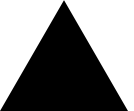What is the Sierpinski Triangle? Let's consider an equilateral triangle. Now remove the equilateral triangle joining the mid-points of the sides of the triangle. Notice that the area of the new figure is $\frac{3}{4}^{\text{th}}$ the initial area. Now lets apply the same procedure to the 3 smaller triangles.



